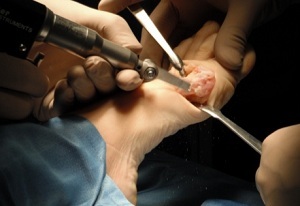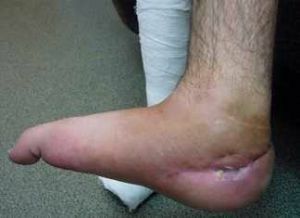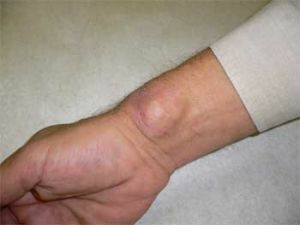 Tendival ganglion or by the principle of communicating vessels. At the first glance at this pathology, an analogy with an intact pea or cherry appears, only the mobility of the "cherry" is considerably limited by the affected area.
Tendival ganglion or by the principle of communicating vessels. At the first glance at this pathology, an analogy with an intact pea or cherry appears, only the mobility of the "cherry" is considerably limited by the affected area.
Binding to the affected joint or tendon for the tendon ganglion( hygroma or ganglion) is mandatory, and at the same time serves as an important differential diagnostic difference from other pathology of the connective tissue of the extremities.
Contents of the article
- The tumor does not seem. ..
- Similar to bursitis, but not bursitis
- For and without reason, the emerging
- Features of the structure
- Clinical picture
- The solution is one - cut as early as possible!
- To exclude relapse
To a tumor does not seem. ..
Although the ending -oma is always a hint of a tumor, the hygroma is not a tumor. After all, the tumor( especially malignant) is a tissue that, swiftly and aggressively expanding, captures the entire living space, sweeping the neighboring tissues under itself.
This same neoplasm grows extremely slowly, and then only when there is a necessity in its existence, under certain conditions.
The second name: the tendon ganglion( ganglion node, hardening, compaction) also does not clarify anything - there is no special density of 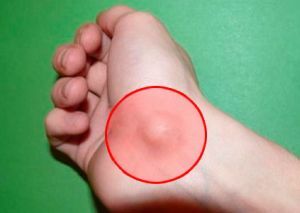 in sight. To the touch, this formation of an elastic-malleable consistency is reminiscent of a rubber ball, not too tightly filled with air.
in sight. To the touch, this formation of an elastic-malleable consistency is reminiscent of a rubber ball, not too tightly filled with air.
What then is this obviously superfluous and unpleasant "bloating" in its appearance, so spoiling the aesthetic perception of the body and significantly hampering life, especially when such education is not one? To understand this allows familiarity with its structure and content.
Autopsy shows that the ganglion is a capsule( cavity) with walls made by the cartilage of the wall of the articular bag, filled with a pale yellow liquid with an insignificant amount of mucus and filaments of fibrin.
The fluid in the tendon ganglion cavity is never purulent or bloody, it is always serous, and always aseptic, so its presence in the cavity never leads to inflammation of the tendon sheath or the wall of the joint capsule from which it is formed.
Similar to bursitis, but not bursitis
This formation is nothing but a buffer created by the body to protect a specific area of the osteoarticular system from the load acting on it, either excessively strong, or prolonged or permanent.
Excessive load can occur with trauma( hammering on the finger, hence the most common formation of tendon nodes at the rear of the hands), and by duration is meant the effect of pressure or friction more or less constant.
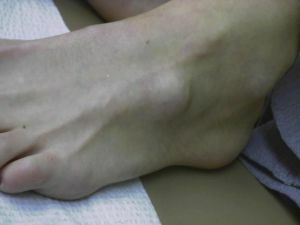
The tendon ganglion of the foot
It can be squeezing the feet with shoes that are not removed during the day, especially - close, "very tightly".That is why on the rear of the foot tendon ganglia appear also often enough. The pressure of excessive body weight on the lower extremities causes their formation in the region of the knee joints.
Here, to protect against such "close" and traumatic influences over the tendon and articular structures, these softening and damping impacts and whims of fate are formed by elastic "pillows" or "bubbles".
The pathology is externally very similar to bursitis, but bursitis is not for two reasons:
- First, the tendon ganglion - is an artificial formation that arises from the external impact of .In fact, it is a hernia of the joint, a "bladder", "blown out" of one of its walls by an excessive increase in pressure inside the joint."Bubble", most often communicating with the cavity of the joint with the help of a narrow neck-anastomosis. Bursitis is the pathology of the articular bag itself.
- Secondly, the ganglion is not an inflammatory disease of .Yes, its basis is the cartilage, as in bursitis, and this cartilage is deformed, mutated. But he is not inflamed, the process of his transformation is aseptic, not infectious or allergic.
If the joint cavity is a natural and necessary formation, then the ganglion cavity with its non-inflammatory contents arises from the effect of the cause purely external.
Therefore, this neoplasm should be considered a cyst due to the degeneration of the synovium( and thickened synovial fluid filled).
For the cause and for no reason, the emerging
The mechanism of ganglion formation becomes clear if we recall that the tendon sheath, like the joint, is a closed cavity filled with fluid that exerts a certain internal pressure on the walls of this cavity.
Suddenly increased external pressure with axial load on the joint leads to a sharp reduction in the volume of the joint cavity.
Liquid trapped in a confined space and sharply compressible, exerts pressure on the walls of its containment cavity, looking for where to splash out.
And this sharp, similar in strength explosion, the pulse pushes the wall of the articular cavity in its weakest place, causing the formation of an additional cavity - "blows out" the hernial "bubble", where a "shot" part of the liquid.
The reason for the operation of this mechanism should be lightning fast( trauma, including sports).
But more often the basis for the emergence of pathology is chronic injuries, in the form of a moderate, but constant from day to day constant or prolonged load. 
This movement, according to the kind of work performed:
- washerwomen;
- cooks;
- pianists;
- seamstresses and embroiderers;
- constantly working on the keyboard of a computer or a typewriter.
But the causes of tendon ganglion may be different:
- tight shoes, frequent callus formation;
- consequences of operative interventions on joints and tendons, or their diseases leading to cartilage degeneration: arthrosis, arthritis, bursitis, tenosynovitis, or their self-treatment;
- is a hereditary conditioned weakness of connective tissue.
Often the cause of the hygroma generally remains unsolved.
Features of the structure
Depending on the cause of its origin and the characteristics of the articular cartilage that has undergone compression, it is possible to form a tendon ganglion:
- single-chamber;
- multi-chamber.
 In turn, the ganglion chamber, which once may have arisen forever to lose communication with the cavity of the joint that gave birth to it-the fistula between them remains, but it is tightly closed and the liquid does not move through it, an isolated type of cavity appears.
In turn, the ganglion chamber, which once may have arisen forever to lose communication with the cavity of the joint that gave birth to it-the fistula between them remains, but it is tightly closed and the liquid does not move through it, an isolated type of cavity appears.
Either the anastomosis remains active, allowing the synovial fluid to flow freely in both directions.
In the third variant, a valve is formed in the joint between the cavities, allowing fluid to flow only one way - into the ganglion cavity, when the pressure in the joint cavity increases.
Clinical picture
A small, sinuous knot of painful sensations does not deliver. Problems begin with the growth of the neoplasm due to the continuation of his traumatization in the process of work and life.
In addition to the discomfort and unaesthetic appearance of this tendon-cartilaginous formation, the picture of the disease is supplemented by such symptoms:
- of various temperaments moderate pains in the formation itself;
- restriction of the functions( movements and sensitivities) of the involved joint or in the body part distal to the arisen block;
- nail deformation due to tissue trophism;
- changes appearing in the skin covering the neoplasm( hyperemia or cyanosis, tightening or thinning of its
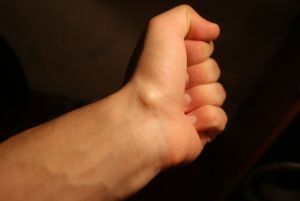 surface, capable of leading to self-exposure).
surface, capable of leading to self-exposure).
Pains can be pulling or aching, arise with pressure on the ganglion or spontaneously, with extension-flexing of the blocked joint, skin sensations can have the character of "numbness" or itching.
Multiple ganglia formed on a hand or foot, can seriously limit the amount of movement in the entire limb.
The solution is one - cut as early as possible!
Regardless of the size, which can be simply huge, and delivered purely technical difficulties, slowly growing, or not growing at all, the neoplasm is characterized by high stability of the cell structure and is not inclined to malignant degeneration.
But at the same time:
- there is a high probability of its damage with subsequent suppuration;
- has a tendency to further growth;
- may cause the appearance of neurological symptoms or trophic disorders that arise in the limb from mechanical compression by the formation of vascular and neural trunks;
- there is a limitation of the amount of motion in the joints of
This is what leads the patient to the surgeon's office. And very often this happens after a stubborn unsuccessful self-treatment, one of the "methods" of which( crushing the tendon junction) should be called simply savage.
Failure to treat a tendon ganglion by pumping a fluid with a syringe or simply opening its cavity is easily explained by its structure: if the communication between the joint cavities and the formation remains, the ganglion cavity is easily refilled due to fluid coming from the joint cavity.
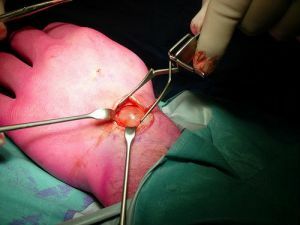 Only radical excision of education with simultaneous restoration of the integrity of the walls of the joint cavity, without leaving the anastomosis, can lead to complete restoration of the function of the affected limb or joint.
Only radical excision of education with simultaneous restoration of the integrity of the walls of the joint cavity, without leaving the anastomosis, can lead to complete restoration of the function of the affected limb or joint.
It is used both traditional surgical and laser excision of this, albeit benign, but nevertheless neoplasms. And to part with it should be as soon as possible, until it became a serious obstacle to work, life and life.
Surgery for removal of tendon ganglion:
To exclude relapse of
To avoid reappearance of tendon ganglion after its prompt removal it is necessary to strictly adhere to the recommendations of a surgeon regarding the mode of work and life. For a premature load on a limb, despite its apparent insignificance, can easily become redundant.
With genetic predisposition to this pathology, it is impossible to exclude the possibility of spontaneous appearance of new "nodes" other than those already existing.
In the same case, when it comes to such a cause of gigrom, like chronic microtrauma of joints and superficial tendons, care should be taken in the performance of work and take measures to change working conditions.

